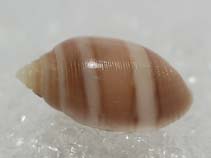| Family: |
Acteonidae () |
| Max. size: |
|
| Environment: |
benthic; marine |
| Distribution: |
Northeast Atlantic and the Mediterranean: Celtic and Lusitanian provinces. |
| Diagnosis: |
Shell: quite thick, fairly short, conical spire with slightly convex whorls, impressed suture, elongated oval in shape; first turns of the shell are heterostrophe (i.e., the axis of coiling forms an angle to the adult shell's columella; very elongated oval aperture, with a thin and sharp outer lip, columellar lip has a light callus and a deep fold at the base; sculpture consists of thin spiral grooves more marked toward the posterior and anterior edges of the whorls; pink hazel in color, with one or two whitish spiral bands; operculum is horny, pale yellow and transparent. Body: very wide foot, differentiated anteriorly into a podium; head broadens into a cephalic disc which has two lateroposterior lobes, incorrectly called tentacles; eyes are sessile; gill, osphradium and penis are inside the mantle cavity; radula lacks rachidial teeth and has a very large number of lateral teeth. |
| Biology: |
Inhabits fine well sorted sand (Ref. 2780). Free-living (Ref. 3123). |
| IUCN Red List Status: |
Not Evaluated (N.E.) Ref. 123251)
|
| Threat to humans: |
|
| Country info: |
|
Source and more info: www.sealifebase.org. For personal, classroom, and other internal use only. Not for publication.

